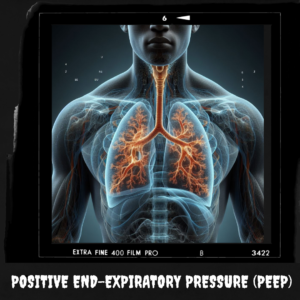Respiratory failure is a critical condition where the respiratory system fails to maintain adequate gas exchange, resulting in hypoxemia (low blood oxygen) or hypercapnia (high blood carbon dioxide). As frontline responders, paramedics must be adept at identifying and managing respiratory failure to prevent serious complications and save lives. This article will delve into the two primary types of respiratory failure—hypoxic and hypercarbic—explaining their differences, signs and symptoms, and appropriate corrective measures. Additionally, we will explore the potential consequences of administering incorrect treatments and discuss how specific adjustments in ventilation settings can correct imbalances.
Types of Respiratory Failure
Hypoxic Respiratory Failure – Hypoxic respiratory failure, also known as type 1 respiratory failure, occurs when there is insufficient oxygenation of the blood. This condition is defined by a partial pressure of oxygen (PaO2) less than 60 mm Hg while breathing room air. Common causes include: – Acute respiratory distress syndrome (ARDS) – Pneumonia – Pulmonary embolism – Pulmonary edema – Chronic obstructive pulmonary disease (COPD)
Signs and Symptoms of Hypoxic Respiratory Failure – Dyspnea (shortness of breath) – Cyanosis (bluish discoloration of the skin, particularly the lips and fingertips) – Confusion or altered mental status – Tachycardia (increased heart rate) – Tachypnea (rapid breathing) – Use of accessory muscles for breathing
Hypercarbic Respiratory Failure – Hypercarbic respiratory failure, or type 2 respiratory failure, is characterized by elevated levels of carbon dioxide (PaCO2 greater than 50 mm Hg) due to inadequate ventilation. It can result from: – Chronic obstructive pulmonary disease (COPD) – Asthma – Drug overdose (e.g., opioids) – Neuromuscular diseases (e.g., myasthenia gravis, Guillain-Barré syndrome) – Severe obesity (obesity hypoventilation syndrome)
Signs and Symptoms of Hypercarbic Respiratory Failure – Dyspnea – Headache – Confusion or decreased level of consciousness – Flushed skin – Tremors or muscle twitching – Asterixis (flapping tremor of the hands)
Recognizing and Correcting Respiratory Failure
Hypoxic Respiratory Failure: Management and Correction
- Oxygen Therapy: Administer high-flow oxygen through a non-rebreather mask or nasal cannula to improve oxygenation.
- Positive Pressure Ventilation: Use continuous positive airway pressure (CPAP) or bilevel positive airway pressure (BiPAP) to enhance alveolar ventilation and oxygenation.
- Intubation and Mechanical Ventilation: In severe cases, endotracheal intubation and mechanical ventilation may be necessary.
- Adjust Ventilator Settings: Increase the fraction of inspired oxygen (FiO2) and tidal volume to enhance oxygen delivery to the alveoli.
- Treat Underlying Cause: Address the root cause, such as administering antibiotics for pneumonia or diuretics for pulmonary edema.
Hypercarbic Respiratory Failure: Management and Correction
- Non-Invasive Ventilation (NIV): Utilize CPAP or BiPAP to reduce the work of breathing and improve ventilation.
- Mechanical Ventilation: For patients who do not respond to NIV or are in severe distress, intubation and mechanical ventilation are required.
- Adjust Ventilator Settings: Increase the respiratory rate and positive end-expiratory pressure (PEEP) to enhance CO2 removal and improve ventilation.
- Medications: Bronchodilators (e.g., albuterol) and corticosteroids (e.g., prednisone) can be used for obstructive lung diseases.
- Reversal Agents: In cases of drug overdose, use specific reversal agents like naloxone for opioid toxicity.
- Addressing Underlying Conditions: Manage neuromuscular causes with appropriate medical or surgical interventions.
The Consequences of Incorrect Treatment Administering the wrong treatment for respiratory failure can have severe and potentially fatal consequences. It’s crucial to distinguish between hypoxic and hypercarbic respiratory failure to avoid worsening the patient’s condition.
Incorrect Treatment for Hypoxic Respiratory Failure
Inadequate Oxygen Therapy: Providing insufficient oxygen to a hypoxic patient can lead to persistent or worsening hypoxemia, causing tissue hypoxia, organ failure, and death.
Over-ventilation: If mechanical ventilation is used inappropriately, it can lead to barotrauma (lung injury caused by over-distention) or volutrauma (lung injury caused by large tidal volumes), exacerbating respiratory distress and potentially causing pneumothorax (collapsed lung).
Incorrect Treatment for Hypercarbic Respiratory Failure
Excessive Oxygen Administration: Administering high-flow oxygen to patients with chronic hypercarbic respiratory failure (e.g., COPD) can reduce their hypoxic drive to breathe, leading to further CO2 retention (hypercapnia), respiratory acidosis, decreased consciousness, and respiratory arrest.
Delayed or Inadequate Ventilatory Support: Failing to provide appropriate ventilatory support (e.g., BiPAP or mechanical ventilation) can result in worsening hypercapnia, leading to severe acidosis, altered mental status, and multi-organ dysfunction.
Call to Action for Paramedics
Recognizing the signs and symptoms of respiratory failure is crucial for timely intervention and improved patient outcomes. As paramedics, your vigilance can make a life-saving difference. Always assess the patient’s airway, breathing, and circulation (ABCs), and be prepared to provide rapid and effective respiratory support.
- Stay Alert: Be aware of the risk factors and clinical presentations of both hypoxic and hypercarbic respiratory failure.
- Perform Rapid Assessments: Use pulse oximetry and capnography when available to monitor oxygen and carbon dioxide levels.
- Act Promptly: Initiate oxygen therapy and ventilation support as needed, and transport the patient to the nearest appropriate medical facility.
- Educate and Communicate: Continuously update your knowledge and skills, and communicate effectively with other healthcare providers to ensure coordinated care.
By understanding the distinctions between hypoxic and hypercarbic respiratory failure and implementing the appropriate corrective measures, you can provide essential care to patients in respiratory distress and contribute to better health outcomes in your community. Stay vigilant, stay informed, and always be ready to act.




